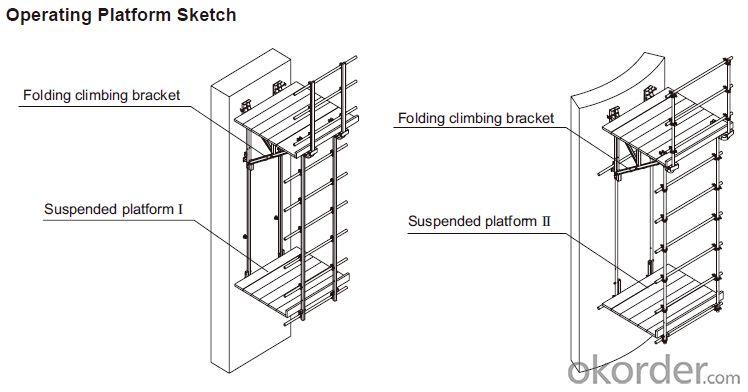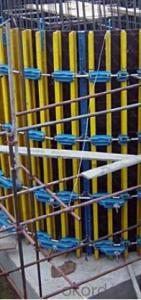Climbing Platform CP--190 for formwork and scaffolding system
- Loading Port:
- Tianjin
- Payment Terms:
- TT OR LC
- Min Order Qty:
- 50 m²
- Supply Capability:
- 1000 m²/month
OKorder Service Pledge
OKorder Financial Service
You Might Also Like
Climbing Platform CP190
Climbing bracket CP190 is mainly used as operating platform during construction. It can be used
on the vertical wall and arced wall. The bracket hang on the anchor system and all the load are
supported by anchor system. It’s convenient to assemble and dismantle, the construction is easy,
rapid and safe.
Anchor System:
Anchor system is the most important supporting part. The system is made of five parts shown
below. There into, tensile bolt, anchor shoe and V-climbing cone can be taken out for reusing.

- Q: Can steel formwork be used for curved or complex shapes?
- Yes, steel formwork can be used for curved or complex shapes. Steel is a highly versatile material that can be easily shaped and molded to fit various geometries, making it suitable for constructing formwork for curved or complex structures. Its strength and durability also make it a reliable choice for these types of applications.
- Q: Can steel formwork be used in sports facility construction projects?
- Yes, steel formwork can be used in sports facility construction projects. Steel formwork offers durability, strength, and versatility, making it suitable for constructing various elements in sports facilities such as stadium seating, columns, beams, and walls. Its ability to withstand heavy loads and provide a smooth finish makes it a popular choice in sports facility construction.
- Q: How does steel formwork handle concrete flowability and workability?
- Due to its durable and rigid nature, steel formwork is highly effective in managing the flowability and workability of concrete. When concrete is poured into the steel formwork, it easily takes on the desired shape, resulting in a smooth and even finish. The support and stability provided by the steel formwork prevent any deformation or movement during the pouring and curing process. The design of the steel formwork ensures that it can withstand the pressure exerted by the concrete, making it capable of handling variations in flowability. With its tight joints and smooth surfaces, the formwork allows for better control of the concrete's flow, preventing any leakage or seepage. This enables precise and uniform placement of the concrete, ensuring consistent quality throughout the structure. Furthermore, steel formwork is highly adaptable, allowing for easy adjustments and modifications to accommodate changes in concrete flowability and workability. It can be quickly assembled, disassembled, and repositioned as needed, providing flexibility in construction projects. In addition, steel formwork offers a high level of reusability. Its durability and resistance to wear and tear make it suitable for multiple placements of concrete, reducing construction costs and environmental impact. In conclusion, steel formwork effectively manages concrete flowability and workability by providing a stable and rigid structure that supports the concrete during placement and curing. Its adaptability, durability, and reusability make it the preferred choice in construction projects requiring precise and consistent concrete finishing.
- Q: Can steel formwork be used for structures with high chemical resistance requirements?
- No, steel formwork is not suitable for structures with high chemical resistance requirements as steel is prone to corrosion and may react with chemicals, compromising the integrity of the structure. Alternative materials, such as chemically resistant plastics or specialized coatings, would be more appropriate in such cases.
- Q: Can steel formwork be used for precast concrete stairs?
- Yes, steel formwork can be used for precast concrete stairs. Steel formwork is highly durable and can withstand the weight and pressure of the concrete during the casting process. It provides a smooth and uniform finish to the precast concrete stairs, ensuring a high-quality end product. Steel formwork also offers flexibility in terms of customization, allowing for the creation of various designs and dimensions for the precast concrete stairs. Additionally, steel formwork can be reused multiple times, making it a cost-effective option for precast concrete stairs production. Overall, steel formwork is a suitable choice for constructing precast concrete stairs.
- Q: Can steel formwork be used for both interior and exterior concrete elements?
- Steel formwork is suitable for both interior and exterior concrete elements. Its versatility makes it applicable to different construction projects. Furthermore, steel formwork is known for its durability, strength, and ability to withstand the pressure exerted by wet concrete. It also provides exceptional dimensional accuracy and ensures smooth and uniform concrete surfaces. Whether constructing interior slabs, walls, or exterior foundations, columns, or beams, steel formwork is a dependable option for both interior and exterior concrete elements.
- Q: What are the considerations when designing steel formwork for bridges?
- When designing steel formwork for bridges, there are several important considerations that need to be taken into account. First and foremost, the structural integrity and stability of the formwork system is of utmost importance. It is crucial to ensure that the steel formwork is capable of withstanding the loads and forces imposed during the construction process. This includes the weight of the wet concrete, as well as any additional loads such as equipment or workers. Another important consideration is the dimensional accuracy and smoothness of the finished concrete surface. The formwork must be designed to provide the desired shape and finish for the bridge components. It should be able to maintain the specified tolerances and prevent any distortion or misalignment during the pouring and curing of concrete. The ease of assembly, disassembly, and reusability of the steel formwork is also a key consideration. The formwork system should be designed to be easily assembled and adjusted to accommodate different bridge geometries. It should also be easy to dismantle and move to the next construction site. Additionally, the ability to reuse the formwork for multiple projects can lead to significant cost savings. The safety of the workers involved in the construction process is another important consideration when designing steel formwork for bridges. The formwork should be designed to provide a safe working environment, with features such as guardrails, access platforms, and proper anchorage systems. It is crucial to adhere to all relevant safety regulations and standards to prevent accidents and injuries. Lastly, the cost-effectiveness of the steel formwork system should be considered. The design should aim to minimize material usage and optimize the construction process to reduce overall costs. This can be achieved through efficient design and manufacturing techniques, as well as the use of high-quality and durable materials. In conclusion, the considerations when designing steel formwork for bridges include structural integrity, dimensional accuracy, ease of assembly and reusability, worker safety, and cost-effectiveness. By addressing these factors, engineers can ensure the successful construction of bridges that meet all requirements and standards.
- Q: How does steel formwork affect the overall waste management of the construction process?
- Steel formwork can have a positive impact on the overall waste management of the construction process. Unlike traditional timber formwork, steel formwork can be reused multiple times, reducing the amount of waste generated during construction. This not only minimizes the need for raw materials but also decreases the amount of waste that needs to be disposed of. Additionally, steel formwork is more durable and resistant to damage, further extending its lifespan and reducing waste. Overall, the use of steel formwork in construction can contribute to a more sustainable and efficient waste management system.
- Q: What are the considerations when designing steel formwork for underground structures?
- When designing steel formwork for underground structures, several considerations need to be taken into account. Firstly, the formwork should be designed to withstand the pressure exerted by the surrounding soil or water. Adequate strength and structural integrity are crucial to prevent collapse or deformation. Secondly, the formwork should be corrosion-resistant, as underground structures are often exposed to moisture and potentially corrosive substances. The use of stainless steel or other corrosion-resistant materials is recommended. Thirdly, the formwork design should facilitate easy installation, removal, and reusability. Underground construction often involves complex geometries and tight spaces, so the formwork should be designed to easily maneuver and install in such conditions. Additionally, considerations should be given to the formwork's ability to provide a smooth and consistent finish to the concrete surfaces. This is important for both aesthetic and functional purposes, as a well-finished surface reduces the need for additional surface treatments and enhances the overall durability of the structure. Lastly, safety measures should be incorporated into the formwork design, ensuring the protection of workers during the construction process. This may include features such as guardrails, access platforms, and proper anchoring systems. Overall, the design of steel formwork for underground structures should prioritize strength, corrosion resistance, ease of installation, surface finish, and worker safety.
- Q: Is steel formwork suitable for projects with limited skilled labor?
- Yes, steel formwork is suitable for projects with limited skilled labor. Steel formwork is a pre-fabricated system that can be easily assembled and dismantled, making it user-friendly even for unskilled laborers. It does not require extensive training or specialized skills to work with steel formwork. Additionally, steel formwork is highly durable and can be reused multiple times, providing cost-effectiveness and reducing the need for skilled labor throughout the project. The strength and stability of steel formwork also ensure accurate and precise construction, even with limited skilled labor. Therefore, steel formwork is a suitable choice for projects where skilled labor is limited, as it allows for efficient and reliable construction without compromising the quality of the project.
Send your message to us
Climbing Platform CP--190 for formwork and scaffolding system
- Loading Port:
- Tianjin
- Payment Terms:
- TT OR LC
- Min Order Qty:
- 50 m²
- Supply Capability:
- 1000 m²/month
OKorder Service Pledge
OKorder Financial Service
Similar products
Hot products
Hot Searches
Related keywords

















